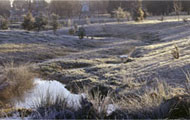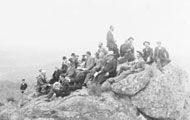- Mt. Canobolas & Lake Canobolas
- Rain & Floods
- Object :: Pluviometer
- Object :: Tipping Bucket
- Object :: Rainfall Records
- Introducing Water in Orange
- Object :: Douglas Pump
- Spiritual Dimensions
- Interview :: Ian Marr
- Object :: Ian Marr Bench
- Interview :: Carl MacKander
- Object :: Baptismal Font
- Object :: Chalices
- Interview :: Mandy Martin
- Wiradjuri People
- Interview :: Joyce Williams
- Object :: Painting by Joanne Reid
- Canowindra Fish Fossils
- Object :: Fossils
- Swamps & Wetlands
- Interview :: Rodney Tonkin
- Interview :: Jill Campbell
- Object :: Willow
Introducing Water in Orange
Orange is isolated from major rivers, relying on perpetual rainfall and an abundant network of creeks. Early explorers followed the main rivers that skirted the district. The original village of Orange was serviced by water reserves along Blackman's Swamp Creek and underground water from many private wells.
The little creek on which the town may be said to be situated, bears the euphonious name of Blackman's Swamp. The only water supply is that of wells but a water scheme is being proposed and sites chosen. From Cassell's Picturesque Australasia 1889.
A windlass and bucket or a pump was used to bring water to the top of the well. Mervyn Henry of Orange said his father George had built wells in Warrendine Street and Franklin Road in the early 20th century and their house in Clinton Street had a Douglas pump with a pipe that reached to the bottom of the well. Wells were not only used as a necessary water supply but were also used as refrigerators by lowering food into them. On occasion the groundwater wells in Orange have dried up leaving the deeper wells with the only reliable supply of water.

View Caption
WT Goodge, editor of the Orange Leader wrote at the time 'the idea of Mr Oliver suggesting that Orange couldn't find enough water for 50,000 people! Why there's more water in (our) streets than there is in Prospect Dam.'
With the introduction of galvanized iron, tanks were installed to collect water from roofs. Most of the tanks were removed in the 1950s and 1960s, however with the recent drought, measures have been made to encourage the installation of tanks once again.
Blackman's Swamp Creek has been known to overflow since the earliest days of settlement. In 1887, work commenced on a drainage system to convey storm water and limit flooding in the middle of town. The stormwater channel was covered in the late 1930s. During World War ll, a section of the channel was reinforced with additional concrete to be used as a shelter in the event of an air-raid.
